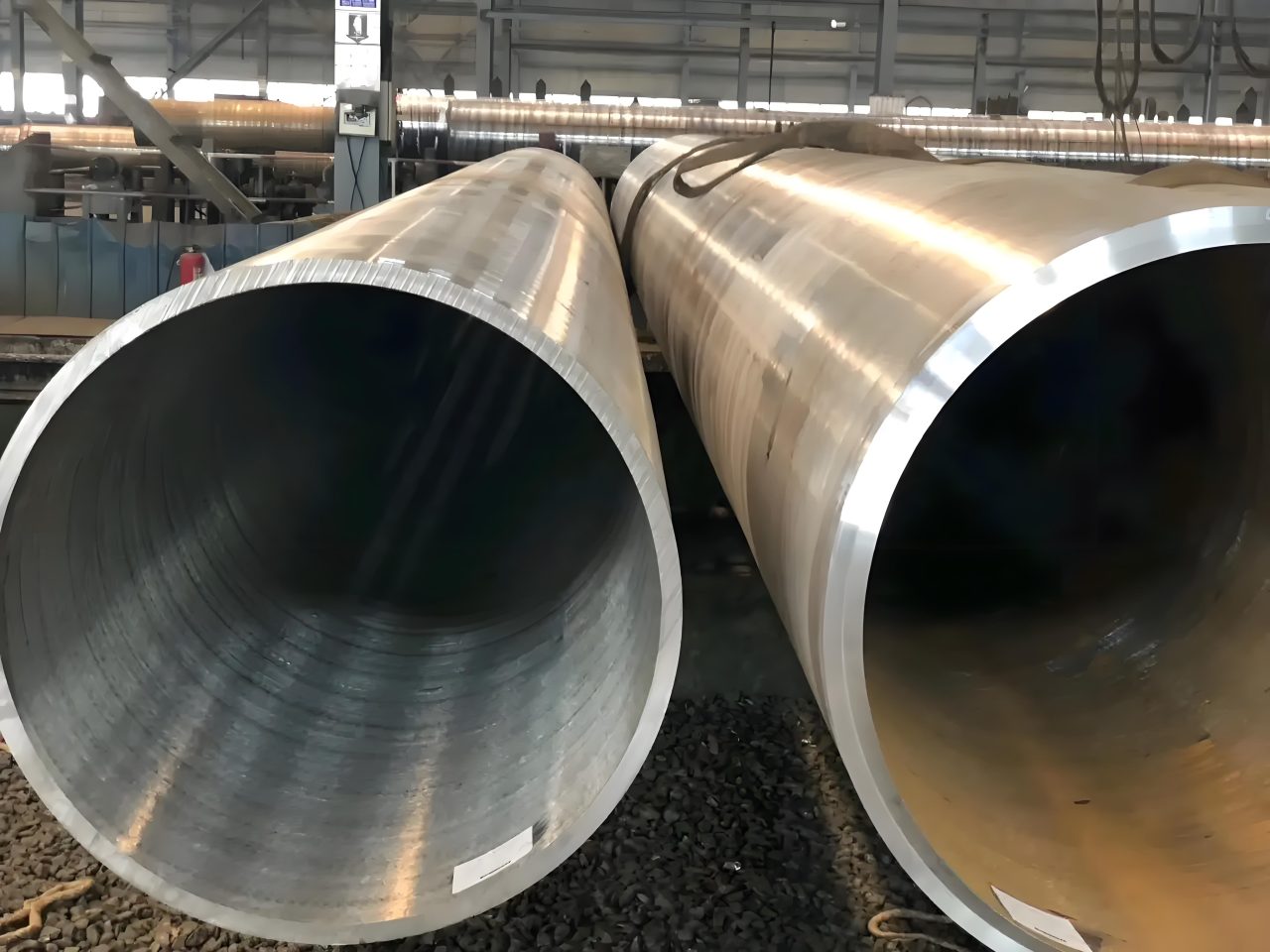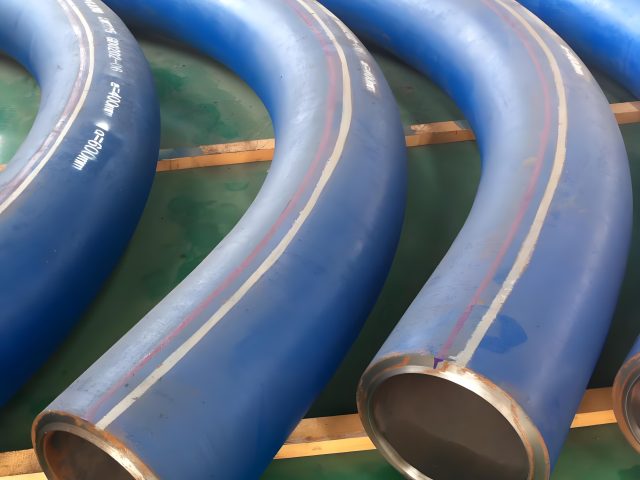API 5L Grado X65 Soldado de alta frecuencia (HFW) Tuberías de acero

Root Cause Analysis: Burst Failure Mechanisms in API 5L Grade X65 High-Frequency Welded (HFW) Tuberías de acero
The modern energy landscape relies heavily on the synergistic performance of two key industrial technologies: **API 5L Grade X65** steel, a high-strength, low-alloy ($\texto{HSLA}$) workhorse, and **High-Frequency Welding ($\texto{HFW}$)**, a rapid, continuo, and highly efficient manufacturing process. When combined, the resulting pipe offers a compelling economic argument for high-pressure, large-volume transmission lines, coupling the material efficiency of X65 ($\texto{450 MPa}$ resistencia al rendimiento mínimo) with the high production throughput of the $\text{HFW}$ mill. Yet, despite the sophistication of both the material and the manufacturing process, failures, specifically catastrophic **burst ruptures**, can and do occur. Analyzing the causes of these failures is perhaps the most critical task in pipeline integrity management, for a burst failure in a high-pressure line is not just a leak—it is a catastrophic loss of containment, a significant environmental hazard, and an event demanding forensic metallurgical scrutiny.
The paradox of the $\text{HFW}$ X65 burst lies precisely in its efficiency. The $\text{HFW}$ proceso, fundamentally an Electric Resistance Welding ($\texto{ACRE}$) variant, relies on heating the longitudinal strip edges to forging temperature using high-frequency current, followed immediately by heavy forging pressure to expel impurities and bond the edges without filler metal. This is a solid-state joining process. The speed and minimal heat input are advantageous, preserving the beneficial microstructure of the $\text{TMCP}$ (Thermo-Mechanical Controlled Processed) X65 steel. Sin embargo, it also creates unique, highly localized vulnerabilities within the weld seam, vulnerabilities that can nucleate, grow under cyclic stress, and ultimately lead to a burst when the internal hoop stress ($\sigma_H$) exceeds the reduced residual strength of the defective section. Our analysis must move beyond simple overpressure to explore the insidious role of manufacturing defects, microstructural anomalies, and electrochemical degradation inherent to the $\text{HFW}$ seam, particularly when coupled with the high operating stresses demanded by the X65 grade.
I. The Primary Mechanism: Lack of Fusion (The HFW Achilles’ Heel)
In the vast majority of $\text{HFW}$ pipe burst failures attributable to manufacturing defects, the root cause traces back to a **Lack of Fusion ($\texto{LOF}$)** along the longitudinal weld seam. This is the structural signature of an imperfect $\text{HFW}$ process and represents a critical planar defect that severely compromises the pipe’s integrity.
The Physics of Insufficient Forging
For the $\text{HFW}$ seam to achieve a true, $100\%$ solid-state bond, three conditions must be met perfectly: the edges must reach the precise forging temperature; the adjacent material must be sufficiently ductile to allow the contaminated material to be expelled (flashing); and the **forging pressure** applied by the squeeze rolls must be adequate to force the clean metal faces together. If the heat input is too low, the forging temperature is insufficient. If the squeeze pressure is too low, the edges are not fully joined. The result is a thin, often microscopic, unbonded region along the weld centerline, or just off the centerline.
This $\text{LOF}$ defect is a failure to join, not a crack, but under the high internal pressure of an X65 line, it acts as a stress concentration point. When the pipe is pressurized, the surrounding sound steel attempts to carry the entire load, but the $\text{LOF}$ defect effectively reduces the **ligament area** resisting the hoop stress. Con el tiempo, or under a surge in pressure, the local stress around the defect exceeds the yield strength, leading to crack initiation at the tip of the $\text{LOF}$ and rapid unstable fracture—the catastrophic burst.
Detection Challenges and $\text{LOF}$ Orientation
A significant factor in $\text{HFW}$ failure is that $\text{LOF}$ defects are typically planar and aligned perfectly parallel to the direction of maximum stress (the hoop stress). While modern pipeline standards (API 5LPSL2) mandate $100\%$ Automated Ultrasonic Testing ($\texto{AUT}$), the effectiveness of $\text{AUT}$ is highly dependent on the orientation of the defect relative to the ultrasonic beam. If the $\text{LOF}$ is perfectly perpendicular to the beam, the signal reflection is strong. Sin embargo, if the geometry is complex or if the defect is slightly misaligned, the signal may be refracted or attenuated, leading to a **false acceptance** of the pipe. A small, undetectable $\text{LOF}$ surviving the mill inspection is a latent time bomb, guaranteed to grow under the cyclic stresses of pipeline operation.
| Defect Type | Mechanism of Formation | Impact on Burst Integrity |
|---|---|---|
| Lack of Fusion ($\texto{LOF}$) | Insufficient heat or forging pressure; oxide entrapment at the interface. | Reduces load-bearing cross-section; high stress concentration; primary source of burst initiation. |
| Stitch-like $\text{LOF}$ | Intermittent $\text{LOF}$ due to fluctuating power or speed. | Links up under cyclic fatigue, leading to a critical defect length. |
| Hook Cracks | Micro-cracks initiating at the weld line, turning into the $\text{ZAT}$. | Sources of fatigue crack growth; often associated with inadequate $\text{ZAT}$ tempering. |
| Internal Scarfing Root | Improper removal of internal weld flash (bead). | Causes localized flow turbulence, erosion, y agrietamiento por corrosión bajo tensión ($\texto{CCS}$) nucleation. |
II. Microstructural Degradation and Brittle Failure
Beyond simple geometric lack of fusion, the intense, localized heating and rapid cooling inherent in the $\text{HFW}$ process can lead to microstructural anomalies in the Heat-Affected Zone ($\texto{ZAT}$) of the X65 steel. These anomalies compromise the material’s toughness, converting a ductile failure mode (a leak) into a brittle, catastrophic rupture (a burst).
Untempered Martensite and Low Toughness
X65 is an $\text{HSLA}$ acero, meaning its strength is derived from specific micro-alloys and thermal processing, not high carbon. Sin embargo, the flash heating of the $\text{HFW}$ process causes the $\text{ZAT}$ to cool extremely rapidly, potentially forming hard, brittle, untempered martensite. Although the pipe is often normalized or tempered post-weld, inadequate or localized post-weld heat treatment ($\texto{PWHT}$) allows these brittle zones to persist. When internal pressure is applied, the high hoop stress finds this low-toughness zone, initiating a fast fracture that consumes little energy, leading to a long, running brittle burst.
Corrosión bajo tensión ($\texto{CCS}$) Initiation
The $\text{ZAT}$ is also highly susceptible to environmental degradation, specifically **Stress Corrosion Cracking ($\texto{CCS}$)**. This is a time-dependent failure mechanism where a small initial defect (like a hook crack or a remaining $\text{LOF}$) grows under the combined influence of sustained tensile stress (internal pressure), cyclic operational loading, and a specific corrosive environment (often the presence of $\text{CO}_2 $, $\texto{h}_2 texto{S}$, o $ texto{pH}$ changes in the soil). The localized, complex microstructure of the $\text{HFW}$ seam can act as a preferential anodic site, accelerating the cracking rate. The $\text{CCS}$ crack grows sub-critically until it reaches a critical depth, at which point the remaining wall thickness fails instantly, causing a burst.
Selective Weld Seam Corrosion ($\texto{CSS}$)
A unique and insidious burst mechanism in older or lower-quality $\text{HFW}$ pipe is **Selective Weld Seam Corrosion ($\texto{CSS}$)**. This occurs when the chemistry and microstructure of the weld metal and the adjacent $\text{ZAT}$ create an anodic area relative to the parent pipe body. The electrochemical potential difference drives localized corrosion specifically along the weld line. This external or internal corrosion acts as a highly localized wall thinning mechanism. For X65 steel, which is designed to operate at very high $\sigma_H$ relative to its wall thickness, even a minor amount of $\text{CSS}$ can reduce the remaining wall thickness below the minimum required for pressure containment, resulting in a sudden, seemingly spontaneous burst.
| Failure Type | Contributing Factor | Mitigation Technique in Manufacturing |
|---|---|---|
| Brittle Fracture | Untempered martensite in $\text{ZAT}$; low $\text{CVN}$ tenacidad. | Mandatory post-weld tempering/normalizing; mandatory $\text{CVN}$ pruebas ($\texto{PSL2}$). |
| Corrosión bajo tensión ($\texto{CCS}$) | High residual stress in $\text{ZAT}$; microstructural heterogeneity. | Weld-zone $\text{PWHT}$ to reduce residual stress; strict $\text{CE}$ control. |
| Selective Seam Corrosion ($\texto{CSS}$) | Chemical or potential difference between weld and parent metal. | Precise control of mill chemistry; proper scarfing to remove segregated material. |
III. Manufacturing Deviations and Service-Induced Fatigue
Beyond the fundamental risks of the $\text{HFW}$ proceso, a burst can often be traced back to manufacturing non-conformities that survived quality control, or defects that grew during the pipe’s operational life under the influence of cyclic loading.
Dimensional Inaccuracies and Residual Stress
While X65 HFW pipe is generally dimensionally excellent, subtle deviations can trigger failure. **Wall Thickness Eccentricity** near the weld seam, where the wall is slightly thinner than the nominal design, immediately increases the local hoop stress. Combined with residual stresses from the welding and scarfing processes, this area becomes a prime candidate for failure. Además, the $\text{HFW}$ process leaves significant **residual tensile stress** transverse to the weld seam. This residual stress acts in summation with the hoop stress from internal pressure, effectively increasing the net tensile load on any internal defect ($\texto{LOF}$ o $ texto{CCS}$ site), accelerating its growth.
Cyclic Fatigue and Delayed Failure
Pipeline operation is rarely constant. Pressure fluctuates daily and seasonally due to demand changes, pumping station cycling, and control adjustments. These pressure cycles induce fatigue loading. Even a small defect, such as a $\text{LOF}$ that was deemed acceptable (or missed) during initial $\text{END}$ or hydrostatic testing, will experience crack growth under this cyclic stress. The crack grows incrementally, cycle by cycle, until its depth or length reaches a critical size defined by the pipe’s operating pressure and fracture toughness. At this critical point, the remaining ligament fails instantaneously—the delayed burst.
This is where the mandatory $\text{PSL2}$ requirements for the hydrostatic test become significant. The initial hydro-test subjects the pipe to $1.25$ a $1.5$ times the maximum operating pressure ($\texto{Maopatina}$). The primary function of this overpressure test is to ‘weed out’ grande, critical defects by forcing them to fail in a controlled environment. If a major $\text{LOF}$ defect survives the hydro-test, it indicates that its remaining strength is greater than the test pressure. Sin embargo, this does not guarantee immunity from fatigue failure, as the defect will continue to grow under the lower, but cyclic, operating pressure until a final, fatal burst.
| Factor | Mechanism | Integrity Consequence |
|---|---|---|
| External Mechanical Damage ($\texto{MD}$) | Third-party damage (p.ej., excavators) creating a gouge or dent. | Creates high stress riser; often linked with low-energy pipe failures. |
| Operational Overpressure | Exceeding $\text{Maopatina}$ due to control system failure or surge. | Simple overloading; failure initiated at the weakest point (often an existing $\text{LOF}$). |
| Water Hammer/Surge | Rapid pressure fluctuation due to valve closure/pump start. | Contributes to high-cycle fatigue, accelerating crack growth at defect tips. |
| Inadequate Scarfing | Internal weld bead remains, causing turbulence, erosion, and flow-accelerated corrosion. | Localized wall thinning and defect nucleation. |
IV. Mitigation and Prevention: The Technical Prescription for Integrity
The forensic analysis of $\text{HFW}$ X65 bursts leads directly to a set of highly specific technical measures aimed at eliminating the critical failure modes identified. For every vulnerability in the $\text{HFW}$ proceso, a stringent control or inspection protocol is necessary.
Mandatory Adoption of PSL2 and Advanced NDT
The single most effective preventative measure is the mandatory specification and use of **API 5L X65 PSL2**. This guarantees: (a) a lower maximum $\text{CE}$ for better weldability; (b) mandated $\text{CVN}$ toughness to ensure crack arrest; y (C) $100\%$ volumetric $\text{END}$ of the weld seam.
Crucially, the $\text{END}$ protocol must go beyond basic radiography. The use of **Automated Ultrasonic Testing ($\texto{AUT}$)** with specialized phased array probes is critical. These probes can be angled precisely to detect the planar $\text{LOF}$ defectos, including those that are slightly misaligned, significantly improving the probability of detection ($\texto{POD}$) compared to traditional methods. Continuous monitoring of the $\text{HFW}$ power input, squeeze roll pressure, and line speed during manufacture is also essential for controlling the weld quality in real-time.
Post-Weld Heat Treatment and Microstructure Control
To eliminate the risk of microstructural brittleness and to manage residual stresses—the precursors to $\text{CCS}$ and brittle fracture—mandatory **Full-Body Normalizing or Weld-Zone Tempering** is prescribed in the technical specifications for high-consequence lines. This secondary heat treatment refines the grain structure of the $\text{ZAT}$, tempering any untempered martensite and significantly lowering the residual tensile stress in the weld area, thereby increasing its toughness and reducing its susceptibility to $\text{CCS}$ growth.
Operation Integrity Management
Finalmente, operational mitigation is non-negotiable. This involves continuous monitoring of the pipe-to-soil potential for the cathodic protection ($\texto{CP}$) system to prevent $\text{CSS}$ and external corrosion. Además, **In-Line Inspection ($\texto{ILI}$)** herramientas, such as Magnetic Flux Leakage ($\texto{MFL}$) and advanced ultrasonic pigs, must be run periodically to detect any remaining $\text{LOF}$, internal corrosion, o $ texto{CCS}$ crack growth before the defect reaches a critical size. By continuously tracking the growth rate of known defects, pipeline operators can predict the remaining life and schedule proactive repairs before a catastrophic burst occurs.
| Failure Mode Targeted | Technical Mitigation Measure | Manufacturing Control |
|---|---|---|
| Lack of Fusion ($\texto{LOF}$) | $100\%$ Automated Ultrasonic Testing ($\texto{AUT}$) with phased array probes. | Real-time control of welding power, forging pressure, and line speed. |
| Microstructural Brittleness ($\texto{ZAT}$) | Mandatory post-weld tempering or normalizing. | Mandatory $\text{CVN}$ testing and low $\text{CE}$ (PSL2). |
| Corrosion/SCC Initiation | Effective $\text{CP}$ system; monitoring pipe-to-soil potential. | Proper internal scarfing to eliminate flow accelerators. |
| Fatigue/Delayed Burst | Regular In-Line Inspection ($\texto{ILI}$) for crack growth tracking. | Hydrostatic Test to $1.25 \times \text{Maopatina}$ to screen critical defects. |
V. Conclusión: The Price of Efficiency
La falla por explosión de una tubería soldada por alta frecuencia X65 rara vez se debe a un solo, evento aislado; es la culminación de una secuencia de errores compuestos donde un defecto de fabricación latente, a menudo una microscópica **Falta de Fusión**, sobrevive a barreras de control de calidad cada vez más complejas, sólo para ser llevado a un tamaño crítico por las tensiones operativas cíclicas de una línea de alta presión. The HFW process offers unparalleled manufacturing efficiency, but this speed carries the risk of microstructural inconsistencies and geometric defects that are challenging to detect. The technical prescription for preventing these catastrophic failures is clear: mandate API 5L PSL2 standards, which enforce high material toughness and low $\text{CE}$; deploy advanced $\text{AUT}$ systems capable of detecting planar defects; and implement continuous integrity management protocols, including routine $\text{ILI}$ and $\text{CP}$ monitoring. Only through this holistic, multi-layered approach—from the steel mill’s heat treatment to the field’s crack monitoring—can the inherent structural risks of the $\text{HFW}$ process be managed, ensuring the X65 steel pipe remains a reliable, unyielding artery of energy transmission.




